When you hear the word “healthy,” Burger King Nutrition is probably not the first place that comes to mind. But the truth is, with the right choices, you can enjoy Burger King while still staying on track with your health and fitness goals and still be mindful of your overall Burger King Nutrition.
In this guide, we’ll break down the calories and macros—including protein, fat, and carbs—of the most popular Burger King menu items as part of a complete Burger King Nutrition overview. And if you want a deeper look at the full nutrition details like sodium, saturated fat, and more, you can always check out the complete breakdown in my Fast Food Nutrition Calculator, which also helps you compare Burger King Nutrition to other chains.
Highlights
-
The basic Hamburger is the lowest-calorie meal at Burger King, coming in at just 250 calories, making it a great choice for light eaters or anyone tracking calories and paying attention to Burger King Nutrition.
-
The lowest-fat option is the 4-piece Chicken Fries, with only 6 grams of fat and 110 calories—a smart pick for a quick, lower-fat snack within your overall Burger King Nutrition plan.
-
For a balanced macro-friendly meal, the Royal Crispy Chicken (without Royal Sauce) is the best option, offering around 440 calories, 15g fat, 54g carbs, and 31g protein, which makes it one of the strongest Burger King Nutrition choices for macro tracking.
-
Currently, Burger King does not offer salads or grilled chicken items, so lighter choices mainly come from smaller sandwiches and portion-controlled sides, especially if you’re trying to optimize your Burger King Nutrition.
Burger King offers a surprisingly wide variety of menu items, which means that no matter what your goals are—cutting calories, tracking macros, or just eating smarter—you can usually find something that fits your lifestyle and aligns with smart Burger King Nutrition choices.
I’ve always believed in flexible dieting, and that means nothing is completely off-limits. Every food has a place in moderation. Whether you prefer Burger King, Chick-fil-A, Wendy’s, McDonald’s, or any other fast-food spot, you can enjoy it and still maintain a healthy, balanced life that respects your Burger King Nutrition goals.
In this guide, we’ll walk through the Burger King menu and highlight some of the smartest, healthiest Burger King Nutrition choices you can make.
Quick note: Burger King’s official nutrition listings can be inconsistent at times—calories and macros often vary, and errors happen—so I’ve cross-checked multiple sources to make sure the Burger King Nutrition numbers you see here are as accurate and up-to-date as possible.
The Healthiest Burger King Menu Items
We’ll be breaking down the entire Burger King menu in this guide, so if you’re looking for a specific item, keep scrolling—you’ll find everything you need below, plus practical Burger King Nutrition guidance for each category.
But before we get into the full breakdown, let’s take a look at some of the overall healthiest choices you can order at Burger King from a Burger King Nutrition perspective.
And remember: the word “healthy” means something different for everyone. What works for one person might not work for another. So instead of using a one-size-fits-all definition, we’ll highlight the smartest options based on different dietary goals and how they fit into your own Burger King Nutrition strategy.
These picks are evaluated using the main macros—fat, carbs, and protein.
We won’t go too deep into cholesterol, sodium, or micronutrients here, but if you want that full breakdown, you can always refer to Burger King’s official nutrition listings to dig even deeper into Burger King Nutrition.
Lowest Calorie Meal Option at Burger King
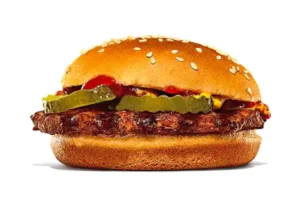
Hamburger – 250 Calories, 10g Fat, 29g Carbs, 13g Protein
If your goal is to keep calories as low as possible, the classic Hamburger is your best pick at Burger King. At only 250 calories, it’s a simple, satisfying choice that won’t blow your daily calorie budget and is one of the most straightforward Burger King Nutrition options for dieters.
Lowest Fat Meal Option at Burger King

4 pc Chicken Fries: 110 Calories, 6g Fat, 8g Carbs, 7g Protein
While there are a handful of options at Burger King Nutrition with 10 grams of fat, a 4 piece order of chicken fries is the lowest fat option with just 6 grams, making it a standout in the overall Burger King Nutrition lineup.
Most Macro-Friendly Meal at Burger King

Royal Crispy Chicken (Without Royal Sauce) – 440 Calories, 15g Fat, 54g Carbs, 31g Protein
If you order the Royal Crispy Chicken sandwich without the Royal Sauce, you instantly cut out about 150 extra calories. With that simple tweak, this sandwich becomes one of the most macro-friendly, high-protein options on the entire Burger King menu and a top Burger King Nutrition pick for lifters and macro-counters.
At around 440 calories and 31 grams of protein, it’s a solid pick for anyone who wants something filling without going overboard.
And if you want a little extra flavor without adding unnecessary calories, stick to hot sauce or mustard—both add great taste with virtually zero impact on your macros or your overall Burger King Nutrition profile.
Calories & Nutrition Facts for Burger King Burgers
A lot of people are surprised when they realize just how low in protein and high in fat Burger King’s burgers actually are when they really look at Burger King Nutrition data.
On paper, a 100% beef, flame-grilled Whopper sounds like it should be loaded with protein. But in reality, the standard Whopper comes in at 670 calories with only 32g of protein, which isn’t nearly as impressive as you might expect from a large beef burger from a Burger King Nutrition point of view.
It’s also important to remember that the Burger King Nutrition stats for each burger include all condiments. Most of the time that means ketchup or mustard, but many sandwiches come with mayo—which adds a lot more calories than people realize.
For example, a Double Whopper without mayo drops down to around 750 calories, which is a huge difference. When possible, skip the heavy condiments and add your own later to better control your calories and improve your overall Burger King Nutrition numbers.
And if you do want mayo, choose “light mayo” instead. It adds about 80 calories, compared to the regular serving that can tack on 160 calories or more, which makes a significant difference in your Burger King Nutrition for the day.
Whopper vs Impossible Whopper Nutrition Comparison
A lot of people are surprised when they realize just how low in protein and high in fat Burger King’s burgers actually are.
On paper, a 100% beef, flame-grilled Whopper sounds like it should be loaded with protein. But in reality, the standard Whopper comes in at 670 calories with only 32g of protein, which isn’t nearly as impressive as you might expect from a large beef burger once you look at the full Burger King Nutrition breakdown.
It’s also important to remember that the nutrition stats for each burger include all condiments. Most of the time that means ketchup or mustard, but many sandwiches come with mayo—which adds a lot more calories than people realize and quickly changes your Burger King Nutrition totals.
For example, a Double Whopper without mayo drops down to around 750 calories, which is a huge difference. When possible, skip the heavy condiments and add your own later to better control your calories.
And if you do want mayo, choose “light mayo” instead. It adds about 80 calories, compared to the regular serving that can tack on 160 calories or more, giving you a more reasonable Burger King Nutrition profile.
Highest Calorie Burger King Burger
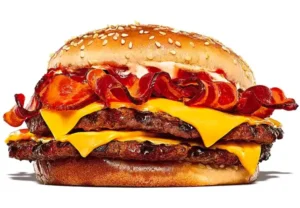
Bacon King – 1,200 Calories, 81g Fat, 56g Carbs, 65g Protein
With a massive 81 grams of fat, the Bacon King is easily one of the highest-calorie items on the Burger King menu. One single burger can push you right up against your entire daily calorie target—so it’s definitely not a light choice from a Burger King Nutrition standpoint.
Why is it so calorie-dense?
Because this thing is loaded. You get two ¼-pound beef patties, which means a full half-pound of meat. On top of that, Burger King adds two strips of thick-cut smoked bacon, two slices of American cheese, and a generous serving of mayo. Put all of that together, and the calorie count makes perfect sense when you look at the overall Burger King Nutrition.
In fact, the Bacon King even beats out the Triple Whopper with Cheese, which clocks in at around 1,170 calories—making the Bacon King one of the most indulgent burgers on the entire menu.
Lowest Calorie Burger King Nutrition

Hamburger – 250 Calories, 10g Fat, 29g Carbs, 13g Protein
Burger King’s classic flame-grilled Hamburger is the lowest-calorie item on the entire menu, making it a great pick for anyone who wants something simple, light, and easy to fit into a calorie-controlled diet and a very beginner-friendly Burger King Nutrition choice.
At only 250 calories, it’s a great option if you are on a diet and trying to keep your calories low.
Most Macro-Balanced Burger
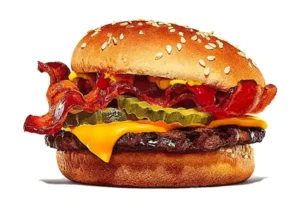
Bacon Cheeseburger – 340 Calories, 16g Fat, 31g Carbs, 18g Protein
Adding cheese and bacon definitely bumps up the fat a bit compared to the classic Hamburger, but surprisingly, it’s only an increase of around 6 grams of fat. For what you’re getting, the overall nutrition of the Bacon Cheeseburger is actually pretty solid in the context of Burger King Nutrition.
If your goal is to shave off a few calories, you can always opt for the regular Cheeseburger instead. But if you enjoy the extra flavor—and let’s be honest, most of us do—the bacon is worth it.
Another strong alternative is the Double Cheeseburger, which comes in at 400 calories. It’s slightly higher than the Bacon Cheeseburger, but you also get 24 grams of protein, making it a great macro-friendly and Burger King Nutrition-friendly option.
Calories and Nutrition Facts for Burger King Chicken
Burger King may be best known for its burgers, but in recent years, they’ve made a serious push into the chicken side of the menu. While staples like Chicken Nuggets and the classic Chicken Fries have been around for years, Burger King has expanded its lineup with several new chicken sandwiches that shift the overall Burger King Nutrition picture.
The Royal Crispy Chicken Sandwich comes in at around 600 calories, which is actually a pretty reasonable number for a fried chicken sandwich. It’s flavorful, filling, and fits comfortably into most calorie goals if you plan ahead and understand your Burger King Nutrition targets.
Burger King also rolled out a series of Royal Crispy Wraps, and these are some of the most calorie-friendly items on the entire menu. Most wraps sit right around 300 calories, making them a great low-calorie, grab-and-go option if you want something quick that won’t derail your day or your Burger King Nutrition plan.
The downside? Burger King still doesn’t offer any grilled chicken options. So if you’re specifically looking for a grilled chicken sandwich, you’ll have better luck at places like Chick-fil-A or Wendy’s, especially if grilled meat is a key part of your personal Burger King Nutrition standards.
Highest Calorie Burger King Chicken Option

Fiery Royal Crispy Chicken: 760 Calories, 47g Fat, 58g Carbs, 34g Protein
Burger King’s Fiery Royal Crispy Chicken is one of the newest – and heaviest – items on the menu, packing 760 calories in a single sandwich.
Is it the healthiest choice? Not really. With 47g of fat and only 34g of protein, it’s not the best option if you’re trying to eat light or stay high-protein.
But if you’re not counting calories, or you need a high-calorie meal to reach your daily goals, this spicy and flavorful chicken sandwich can be a great pick. It’s tasty, filling, and perfect for anyone who wants a bold, satisfying bite as part of a high-calorie Burger King Nutrition day.
Lowest Calorie Burger King Chicken Option

4pc Chicken Nuggets: 190 Calories, 12g Fat, 11g Carbs, 9g Protein
A 4-piece order of Burger King’s chicken nuggets may be small, but it’s also one of the lowest-calorie items on the menu, coming in at only 190 calories, which makes it an easy win in the Burger King Nutrition category for light eaters.
The protein isn’t as high as you might expect from chicken—just 9 grams—but the low calories make these nuggets a light and easy snack. Each piece is roughly 50 calories, making portion control simple.
If you want to keep your meal light, the Honey Mustard Royal Crispy Wrap is another smart option. With just 290 calories, it’s not the most filling item, but it’s a solid low-calorie choice when you want something flavorful without going overboard—and still consistent with smarter Burger King Nutrition habits.
Most Macro-Balanced Chicken at Burger King

8 Piece Chicken Fries: 220 Calories, 12g Fat, 16g Carbs, 13g Protein
Burger King’s 8-piece Chicken Fries are one of the most balanced items on the menu. At just 220 calories with 13 grams of protein, they’re not the highest-protein option, but they’re surprisingly solid for a light, snack-size portion and a very macro-friendly Burger King Nutrition choice.
Since the fat, carbs, and protein all fall between 12–16 grams, Chicken Fries are a great macro-friendly choice—especially if you want something tasty without going over your calorie limit.
Essentially, Chicken Fries are chicken nuggets shaped like long fries, so the nutrition is very similar. Many people prefer them because they offer a great chicken-to-breading ratio and hold dipping sauces well.
If you like a kick, the Fiery Chicken Fries are another option. The same 8-piece serving has 260 calories and 12 grams of protein, which still keeps it in the light and reasonable range for smart Burger King Nutrition planning.
Calories and Nutrition Facts for Burger King Sides and Sauces
What’s a burger without a good side? Whether you love classic French Fries, crispy Onion Rings, or Burger King’s newer “Have-sies” (a mix of both), there are plenty of options to round out your meal and still keep your overall Burger King Nutrition in check with the right portions.
Unfortunately, Burger King no longer offers salads. They’ve been off the menu for a few years now, and while it would be great to see them return one day, it doesn’t seem likely any time soon.
When it comes to sides, you generally won’t find many “healthy” choices. With no vegetable-based sides available, your best strategy is simple portion control, which is one of the easiest ways to manage your Burger King Nutrition overall.
If you’re watching calories, stick to a value size or small portion. Whether you choose fries, onion rings, or Have-sies, the smaller sizes usually fall between 200–300 calories, making them easier to fit into a balanced meal.
When paired with a lower-calorie burger or chicken item, adding an extra 200–300 calories for a delicious side isn’t too bad at all.
Just remember one thing: dipping sauces add up fast. Depending on how much you use, the sauce alone can bump your meal’s calorie count more than you expect and significantly change the final Burger King Nutrition numbers.
Highest Calorie Burger King Side

12pc Mozzarella Fries: 730 Calories, 36g Fat, 71g Carbs, 29g Protein
For a deep-fried, cheese-filled side, it’s no shock that the 12-piece Mozzarella Fries pack a hefty 730 calories. But what might surprise you is how much protein they offer—an impressive 29 grams, which is actually more than Burger King’s Original Chicken Sandwich, while landing in a very similar calorie range and making them a unique outlier in the Burger King Nutrition side menu.
If 730 calories feels too heavy, Burger King also offers 4-piece and 8-piece options, making it easy to choose a lower-calorie portion while still enjoying that crispy, cheesy flavor.
Lowest Calorie Burger King Side

4pc Cheesy Tots: 150 Calories, 6g Fat, 20g Carbs, 4g Protein
While this is a small side with only 4 tots, the flavor packs a punch. If you’re in the mood for something cheesy, these are a solid low-calorie option that fits nicely into a controlled Burger King Nutrition day.
Any value size side is also going to be low in calories, so they make for great options as well.
For example, a value size of onion rings contains just 200 calories, which would pair nicely with any meal.
Most Macro-Balanced Chicken at Burger King
8 Piece Chicken Fries: 220 Calories, 12g Fat, 16g Carbs, 13g Protein
The Chicken Fries from Burger King are one of the most well-rounded options on the menu. With 220 calories and 13g of protein, it may not be the highest source of protein, but it’s certainly solid for what you get and a dependable Burger King Nutrition choice.
With the fat, carbs, and protein all between 12-16 grams, it really doesn’t get much more macro-friendly than that.
Truthfully, Chicken Fries are just chicken nuggets in the shape of long fries, so the nutrition is very similar to the chicken nuggets. I enjoy the chicken fries a lot, though! To me, it’s the perfect chicken-to-breading ratio.
If you prefer spicy, the same size Fiery Chicken Fries will come to 260 calories and 12 grams of protein, which is still respectable.
Calories and Nutrition Facts for Burger King Sides and Sauces
What’s a burger without a great side to go with it? Whether you prefer classic French Fries, crispy Onion Rings, or Burger King’s new “Have-sies” (a half-fries, half-rings combo), there’s no shortage of tasty add-ons to round out your meal as long as you keep your Burger King Nutrition goals in mind.
Unfortunately, Burger King no longer offers salads. They’ve been off the menu for several years now, and while it would be nice to see them return, it doesn’t seem likely anytime soon.
Since there are no vegetable-based sides, choosing a side at Burger King is really all about portion control, not finding the “healthiest” option. If you’re watching your calories, it’s best to stick with a value or small size. Whether you go for fries, onion rings, or Have-sies, the smaller portions usually stay within 200–300 calories, making them easier to fit into your meal and overall Burger King Nutrition plan.
When paired with a lower-calorie burger or chicken item, adding an extra 200–300 calories for a delicious side is completely manageable.
Just keep an eye on the dipping sauces—they may seem small, but if you use a lot of them, those extra calories can add up quickly and impact your Burger King Nutrition totals.
Highest Calorie Burger King Side
12pc Mozzarella Froes: 730 Calories, 36g Fat, 71g Carbs, 29g Protein
Considering this is a large portion of a deep-fried side dish, it doesn’t come as a surprise that it’s relatively high in calories, but it’s pretty impressive when it comes to protein as well in terms of overall Burger King Nutrition.
With 29 grams of protein and 730 calories, it weighs in with more protein than the Original Chicken Sandwich with roughly the same amount of calories.
Burger King also gives you the option to order a 4 or 8 mozzarella fries, so you can easily grab a lower-calorie version if needed.
Lowest Calorie Burger King Side
4pc Cheesy Tots: 150 Calories, 6g Fat, 20g Carbs, 4g Protein
While this is a small side with only 4 tots, the flavor packs a punch. If you’re in the mood for something cheesy, these are a solid low-calorie option that still fits into smart Burger King Nutrition planning.
Any value size side is also going to be low in calories, so they make for great options as well.
For example, a value size of onion rings contains just 200 calories, which would pair nicely with any meal.
Most Macro-Balanced Side at Burger King
4pc Mozzarella Fries: 240 Calories, 12g Fat, 24g Carbs, 10g Protein
While 10 grams of protein may not seem like a lot of protein, with only 240 calories overall, the mozzarella sticks are pretty well-balanced overall and a solid Burger King Nutrition side pick.
If you need a side with more protein, the chicken options (chicken nuggets or chicken fries) are better overall, but for a delicious side dish that is NOT made of meat, the mozzarella sticks are a solid option.
Calories and Nutrition Facts for Burger King Breakfast
It doesn’t get any better than breakfast, and Burger King has quite the robust breakfast menu when you look at overall Burger King Nutrition options.
I wanted to break it up into two separate graphics because there are a lot of breakfast items. Above you will find all of the breakfast sandwiches, and here is everything else currently offered…
No matter what you prefer for breakfast, Burger King likely has a breakfast option that you’ll love.
Burger King breakfast sandwiches may contain ham, bacon, sausage, or any combination of the three (or none, of course), and come on either a croissant or biscuit.
Unfortunately, there are no egg white options or lower-calorie alternatives like English Muffins or regular bread. For options like that, you’ll need to head on over to McDonald’s or Starbucks, especially if leaner breakfast choices are important to your Burger King Nutrition approach.
If you prefer a sweet breakfast, Burger King also offers French Toast sticks or pancakes. Pair any Burger King breakfast with hash browns and some iced coffee, and you’ve got yourself a great start to the day.
Highest Calorie Burger King Breakfast Option
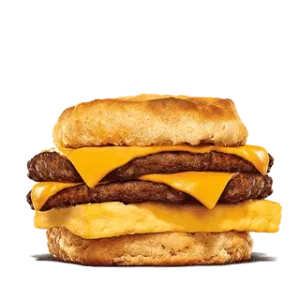
Double Sausage Egg, & Cheese Biscuit: 855 Calories, 66g Fat, 34g Carbs, 33g Protein
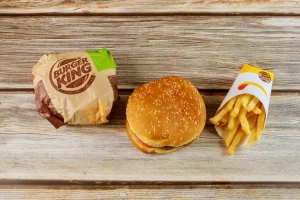
If you’ve read this far, first of all, thank you. You’re a gem.
Second of all, I’m assuming that means that you are relatively interested in saving some calories at Burger King and dialing in your personal Burger King Nutrition approach.
Here are three of my best calorie-saving tips for Burger King’s menu:
1. Go light on the condiments.
You can leave the condiments off altogether to save even more calories, but assuming you still want some flavor, you have the option to ask for “light” of any condiment.
Here are some examples of the calorie savings you’ll see if you ask for light condiments:
- Whopper with light mayo: saves 80 calories
- Royal Crispy Chicken with light Royal Sauce: saves 70 calories
- Original Chicken Sandwich with light mayo: saves 100 calories
Essentially, asking for “light” condiments cuts the amount in half, so if you leave it off altogether, you can save twice as many calories and significantly improve your Burger King Nutrition numbers.
I like to skip the mayo and opt for a lower-calorie sauce like ketchup or hot sauce. In some cases, you can save 200 calories that way.
2. Ask for no cheese
Whether you’re ordering a burger, chicken sandwich, or breakfast sandwich, there’s a good chance it’s going to have cheese on it.
And while it’s tough to get rid of that deliciously melty American cheese, if you’re looking to save calories, leaving the cheese out is an easy way to do it.
Each slice of American cheese contains 40 calories, so if your sandwich contains 2 slices of cheese, asking for no cheese is an easy way to quickly save nearly 100 calories and tighten up your Burger King Nutrition for the day.
3. Be mindful of dipping sauces
Burger King offers a bunch of different dipping sauces, so if you are watching your calories, just be mindful of how much you are using with your chicken nuggets, fries, or onion rings.
Not using any dipping sauce will save you calories, but where is the fun in that?
When you’re dipping nuggets, it’s very easy to quickly go through multiple packets of sauce. However, if you’re using something like the zesty sauce, you’re looking at an extra 300-400 calories.
If you’re using a dipping sauce, try to stick to one packet. And if you can help it, skip the dairy-based sauces like ranch as they tend to be very high in calories and can quietly push your Burger King Nutrition totals much higher than you intended.
Eating Low Carb at Burger King

When it comes to carbs in Burger King food, you may find it tough to find solid low-carb options.
A lot of people are in search of low-carb options when eating out, so I’d love to point you in the right direction.
Unlike other fast-food restaurants like Chick-fil-A, Burger King Nutrition does not offer salads, so the low-carb options are limited.
In order to eat low-carb at Burger King, you’ll need to order a burger, chicken sandwich, or breakfast sandwich with no bun or condiments.
Now, that’s not my area of expertise, so I recommend you check out Hip2Keto’s keto-friendly Burger King guide for some order inspiration.
In this guide I show you the total carbohydrates, the keto-friendly options give you the net carb counts, dietary fiber, how many g sugar, and all the important info you need for a keto or low-carb diet!
Conclusion: Is Burger King Healthy?
So, is Burger King healthy? The honest answer is: it depends on what you order and how you customize it and how you think about Burger King Nutrition in your overall diet.
Burger King’s menu isn’t built around low-calorie or nutrient-dense options, but with the right choices, you can still enjoy a meal without going far over your daily goals. Items like Chicken Fries, small sides, low-calorie wraps, and simple Burger King Nutrition choices can all fit into a balanced eating plan—especially if you use smart strategies like asking for light condiments or skipping the cheese.
Of course, Burger King also offers plenty of indulgent items, from high-calorie sandwiches to milkshakes and cheesy sides. These aren’t “healthy,” but they can absolutely be enjoyed in moderation.
At the end of the day, Burger King can be part of a healthier lifestyle when you focus on portion control, choose lighter options, and customize your order wisely. It’s all about balance and making thoughtful Burger King Nutrition choices based on your goals.


